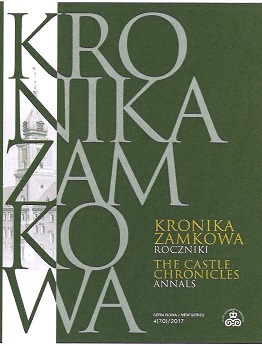Ceremoniał przyjęcia ambasadora hiszpańskiego Francisca de Mendozy na warszawskim dworze Wazów w roku 1597.
The ceremonial procedures of receiving the Spanish ambassador Francisca de Mendoza at the court of the Vasas in Warsaw in 1597.
Author(s): Ryszard SkowronSubject(s): Fine Arts / Performing Arts, History of Art
Published by: Arx Regia® Wydawnictwo Zamku Królewskiego w Warszawie – Muzeum
Keywords: diplomatic ceremonial; Francisco de Mendoza; Admiral of Aragon; Zygmunt III; Thomas Sailly
Summary/Abstract: The lack of written norms and books on ceremonial procedure meant that learning about the etiquette and diplomatic protocol which functioned at the court of the Polish kings had to be based on examples from national and foreign sources which would reveal a system of uncodified protocols and patterns and would determine what was permanent, consistent and repetitive and would also indicate practices which were different, unique, as well as precedents. In 1597, one diplomat, who left a great deal of documentation relating to his diplomatic mission to Poland, was the Spanish Ambassador Extraordinary, Francisco de Mendoza, Admiral of Aragon. Already in the year after the diplomat’s mission was completed, Thomas Sailly—a Jesuit and member of the envoy’s retinue—published in Brussels, an account in Latin of the ambassador’s missions to the Emperor, the Archdukes of Austria and Zygmunt III; there is also an account, in Spanish, of the ambassador’s stay at the Polish court. The article contains a description and analysis of the following ceremonies: the envoy’s official entry into the city, his public audience with King Zygmunt III; his public audience with Queen Anna and the presentation of gifts to her; the Masses on carnival Sunday with the ambassador’s participation; the official banquet hosted by the king and queen; the private audience with the king, the farewell audiences and the ambassador’s presence at private banquets organized by Polish ministers. Both parties—the Polish Court and the Spanish Ambassador—observed diplomatic protocol; at the court in Warsaw all these principles were in line with European standards, as is clearly indicated in the accounts analysed. The adopted ceremonial became an important tool by which the king of Poland wanted not only to end the misunderstanding with Philip II of Spain, but also to gain his favour. Zygmunt III, using ostensibly subtle gestures and distinctions, skilfully raised the ambassador’s prestige—which had a positive effect on the course of the negotiations and the fulfilment of both parties’ political intentions.
Journal: Kronika Zamkowa. Roczniki
- Issue Year: 4/2017
- Issue No: 4
- Page Range: 25-46
- Page Count: 22
- Language: Polish

